| 485 | Goal Zero Sherpa | 2011-09-28 |

To help solve our electricity needs on longer camping trips, we purchased the Goal Zero Sherpa 120. The Sherpa 120 is the big brother of the Sherpa 50. The major difference is the capacity (and weight) of the two systems.
In years past, we have always had trouble keeping our laptops charged while on trips. Our summer trips have lasted up to 60 days; but are mostly car camping. Trying to write the Metro to Mountain Journal entries was difficult unless we drove to town, ate at a restaurant (or coffee shop), and used their electricity. Most restaurants were happy to allow us to charge our computers; but you still have to go to town, find a plug, and sit there while your devices are being charged. We needed a better solution.
Researching, we found Goal Zero. The company makes portable solar power systems using solar arrays for collecting and batteries for storage. Founded to meet the needs of providing power and light in the Democratic Republic of Congo, Goal Zero's products are well adapted for use by adventurers.
The Goal Zero Nomad Solar Panel looks very similar to other folding solar arrays on the market, such as the Brunton. They are probably all made by the same manufacturer; but ours works so we have no complaints.
What we really liked about the Goal Zero System is the Lithium-Ion battery. The battery is fast charging and relatively lightweight. For inputs the battery accepts the cable from the solar panel and from AC or DC chargers. (I think we had to buy the DC charger separate). Outputs include the 12V DC socket, which can also be used with an inverter for AC, and a USB plug.
In use, I set the solar array in the optimal position for capturing the sun's rays. Next, I connected the array to the battery. Lastly, I connected my MacBook laptop to the battery and found a shady place to work. The battery charged my laptop, while the solar charger powered the battery. My laptop used more power than the solar array provides; therefore it caused a slow drain on the Goal Zero battery. When I finished working, my laptop was fully charged; but the Goal Zero battery had lost 20 to 40 percent of it's charge. I allowed the Goal Zero battery to re-charge, which was fairly fast, before taking down the array. The system worked.
A few Goal Zero notes ...
We have no affiliation nor religious affiliation with Goal Zero. They do seem to be a good company that make good products.
Our Sherpa 120 had some minor issues with the gauge. As much as we hated to, we finally chose to do send it back. The battery cost too much not to have it working properly. Goal Zero promptly replaced the battery.
We wished for better product manuals or documentation. There are lots of cables that we learned to use through experimentation.
I called and asked the company if I could put the array in the car window like a sun shade. They replied that it should work. I tried it once. The windshield was so hot, if it had rained, I am sure the windshield would have shattered.
We looked for ways to hang or set the array outside (securing it with bungy cords) while storing the battery inside the tent or vehicle.
The online chart of charging times for batteries and devices was different than information given in the pamphlets that were sent with the products.
Our actual charging times were better than either the online chart or the pamphlet.
For laptop charging we purchased a 12V DC power block for charging. The DC plug charged the laptop in the vehicle and when hooked to the Sherpa Battery it did not lose any power converting DC to AC.
The solar-battery system was expensive. However, if we spend five dollars for gas and five dollars a piece on coffee and a pastry each time we needed to work, over a sixty day period ... the cost of not having a charging system adds up quickly. The Goal Zero almost paid for itself after the first summer.
By the end of the summer we were obsessed with power and keeping things charged.
Happy Goal Zero trails